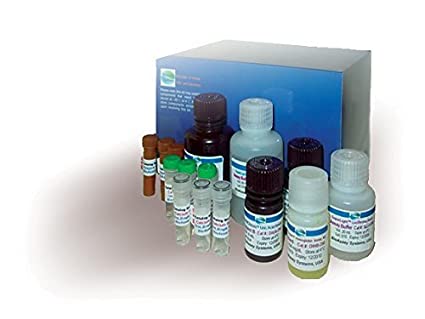Zinc Assay Kit
General description
Zinc, one of the most abundant trace metals in living organisms, contributes to a variety of biological functions, including neurodevelopment, nucleic acid metabolism and signal transduction. Zinc is used as a cofactor for many enzymes, such as carbonic anhydrase, which is important for the regulation of carbon dioxide, and carboxypeptidase, which cleaves peptide bonds.
The Zinc Assay Kit provides a simple and direct procedure for measuring zinc in a variety of samples, including serum, plasma, urine, or cerebrospinal fluid (CSF). Zinc ions bind to a ligand, resulting in a colorimetric (560 nm) product that is proportional to the amount of zinc present.
Zinc, one of the most abundant trace metals in living organisms, contributes to a variety of biological functions, including neurodevelopment, nucleic acid metabolism and signal transduction.
Zinc is used as a cofactor for many enzymes, such as carbonic anhydrase, which is important for the regulation of carbon dioxide, and carboxypeptidase, which cleaves peptide bonds. It is involved in various cellular processes, such as immune function, wound healing, protein synthesis, DNA synthesis and cell division.
Zinc promotes normal growth and development during pregnancy, childhood and adolescence. It also exhibits antioxidant properties and is essential for a good sense of taste and smell.

Zinc is the second most abundant trace mineral in the body and is found in more than 300 metalloenzymes. Carbonic anhydrase, alkaline phosphatase, DNA and RNA polymerases could be listed as important examples. Due to its multiple biochemical functions, zinc deficiency is manifested by a variety of conditions. In cases of clinical deficiency, growth retardation and lightheadedness, impaired immune function, diarrhea, skin lesions, and alopecia are observed. Subclinical deficiency has effects on immune function, hormone synthesis and action, and neurological function.
Zinc is the second most abundant trace mineral in the body and is found in more than 300 metalloenzymes. Carbonic anhydrase, alkaline phosphatase, DNA and RNA polymerases could be listed as important examples. Due to its multiple biochemical functions, zinc deficiency is manifested by a variety of conditions. In cases of clinical deficiency, growth retardation and lightheadedness, impaired immune function, diarrhea, skin lesions, and alopecia are observed. Subclinical deficiency has effects on immune function, hormone synthesis and action, and neurological function.
The zinc found in the samples changes the red-orange color of 5-Br-PAPS to light pink under alkaline conditions. The change in absorbance at 548 nm is proportional to the level of total zinc in the sample. The assay can be calibrated with zinc sulfate dissolved in deionized water.
Suitability
Suitable for measuring zinc concentrations in a variety of samples, including serum, plasma, urine or cerebral spinal fluid (CSF).
Principle
The Zinc Assay Kit provides a simple and direct procedure for measuring zinc in a variety of samples, including serum, plasma, urine, or cerebrospinal fluid (CSF). Zinc ions bind to a ligand, resulting in a colorimetric (560 nm) product that is proportional to the amount of zinc present.
Product overview
Zinc Assay Kit ab102507 is a convenient colorimetric assay in which zinc binds to a ligand developing absorbance at 560 nm. The zinc assay can be used with biological samples such as serum, plasma, CSF or urine with a detection sensitivity of 0.2 µg/ml (~1-3 µM).
Summary of the zinc assay protocol:
- - add samples and standards to wells
- - add reaction mixture and incubate for 10 min
- - analyze with a microplate reader
Notes
Zinc, a metallic chemical element, symbol Zn and atomic number 30 is chemically similar to Magnesium due to its similar size and only oxidation state of 2+. Zinc is an essential mineral of great biological significance, as many enzymes require it as an essential cofactor.
